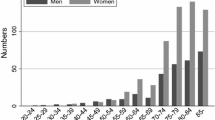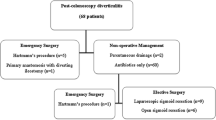Abstract
Background
Diverticulosis, a prevalent condition at screening colonoscopy, has been associated with colorectal cancers that develop after a clearing colonoscopy, or interval cancers.
Aims
To quantify the overall risk of diverticulosis in the development of interval cancers and examine this association in relevant subgroups.
Methods
Using a linked database containing SEER tumor registry data and Medicare claims, we identified patients aged ≥69 years with colorectal cancer who underwent colonoscopy within 6 months of diagnosis. Patients with an additional colonoscopy from 36 to 6 months prior to cancer diagnosis were characterized as having interval cancers. We compared characteristics of patients with interval cancers and detected cancers according to a diagnosis of diverticulosis not associated with a colonoscopy procedure from 1991 through the date of the most recent colonoscopy in both univariate and multivariate models.
Results
A previous diagnosis of diverticulosis was documented in 14,452 (26.9 %) patients with detected cancers compared to 2,905 (69.3 %) patients with interval cancers (p < 0.001); these results were consistent in multivariable analysis. Moreover, the association was found as well in the proximal colon (OR 2.88, 95 % CI 2.66, 3.12), distal colon (OR 3.56, 95 % CI 3.09, 4.11), and rectum (OR 4.07, 95 % CI 3.34, 4.95). The vast majority of diverticulosis diagnoses were without complications such as hemorrhage or diverticulitis.
Conclusions
Diverticulosis was strongly associated with interval colorectal cancers in all segments of the colon. Given its known predominance in the left colon, the findings argue against impaired visualization of lesions at colonoscopy as the only pathogenic factor.
Similar content being viewed by others
References
Haseman JH, Lemmel GT, Rahmani EY, Rex DK. Failure of colonoscopy to detect colorectal cancer. Gastrointest Endosc. 1997;45:451–455.
Pabby A, Schoen RE, Weissfeld JL, et al. Analysis of colorectal cancer occurrence during surveillance colonoscopy in the dietary Polyp Prevention Trial. Gastrointest Endosc. 2005;61:385–391.
Robertson DJ, Greenberg ER, Beach M, et al. Colorectal cancer in patients under close colonoscopic surveillance. Gastroenterology. 2005;129:34–41.
Cooper GS, Xu F, Barnholtz Sloan JS, Schluchter MD, Koroukian SM. Prevalence and predictors of interval colorectal cancers in Medicare beneficiaries. Cancer. 2012;118:3044–3052.
Samadder NJ, Curtin K, Tuohy TMF, et al. Characteristics of missed or interval colorectal cancer and patient survival: a population-based study. Gastroenterology. 2014;146:950–960.
Baxter NN, Goldwasser MA, Paszat LF, Saskin R, Urbach DR, Rabeneck L. Association of colonoscopy and death from colorectal cancer. Ann Intern Med. 2009;150:1–8.
Singh H, Turner D, Xue L, Targownik LE, Bernstein CN. Risk of developing colorectal cancer following a negative colonoscopy examination. JAMA. 2006;295:2366–2373.
Singh H, Nugent Z, Mahmud SM, et al. Predictors of colorectal cancer after negative colonoscopy: a population-based study. Am J Gastroenterol. 2010;105:663–673.
Singh H, Nugent Z, Demers AA, Demers AA, Bernstein CN. The reduction in colorectal cancer mortality after colonoscopy varies by site of the cancer. Gastroenterology. 2010;139:1128–1137.
Bressler B, Paszat LF, Chen Z, Rothwell DM, Vinden C, Rabeneck L. Rates of new or missed colorectal cancers after colonoscopy and their risk factors: a population-based analysis. Gastroenterology. 2007;132:96–102.
Singh H, Nugent Z, Demers A, Bernstein CN. Rate and predictors of early/missed colorectal cancers after colonoscopy in Manitoba: a population-based study. Am J Gastroenterol. 2010;105:2588–2596.
Brenner H, Hoffmeister M, Arndt V, Stegmaier C, Altenhofen L, Hang U. Protection from right- and left-sided colorectal neoplasms after colonoscopy: a population-based study. J Natl Cancer Inst. 2010;102:89–95.
Patel SG, Ahnen DJ. Prevention of interval colorectal cancers: what every clinician needs to know. Clin Gastroenterol Hepatol. 2014;12:7–15.
Potosky AL, Riley GF, Lubitz JD, Mentnech RM, Kessler LG. Potential for cancer related health services research using a linked Medicare-tumor registry database. Med Care. 1993;31:732–748.
Warren JL, Klabunde CN, Schrag D, Bach PB, Riley GF: Overview of the SEER-Medicare data. Med Care 2002; 40:IV-3-IV-18.
Rex DK, Petrini JL, Baron TH, et al. Quality indicators for colonoscopy. Gastrointest Endosc. 2006;63:S16–S28.
Francis DL, Rodriguez-Correa DT, Buchner A, Harewood GC, Wallace M. Application of a conversion factor to estimate the adenoma detection rate from the polyp detection rate. Gastrointest Endosc. 2011;73:493–497.
Williams JE, Le TD, Faigel DO. Polypectomy rate as a quality measure for colonoscopy. Gastrointest Endosc. 2011;73:498–506.
Klabunde CN, Warren JL, Legler JM. Assessing comorbidity using claims data. Med Care. 2002;40:26–35.
Stryker SJ, Wolff BG, Culp CE, Libbe SD, Ilstrup DM, MacCarty RL. Natural history of untreated colonic polyps. Gastroenterology. 1987;93:1009–1013.
Brenner H, Hoffmeister M, Stegmaier C, Altenhofer L, Haug U. Risk of progression of advanced adenomas to colorectal cancer by age and sex: estimates based on 810,149 screening colonoscopies. Gut. 2007;56:1585–1589.
Baker SR, Alterman DD. False-negative barium enema in patients with sigmoid cancer and diverticulosis. Gastrointest Radiol. 1985;10:171–173.
Martel J, Raskin JB. History, incidence and epidemiology of diverticulosis. J Clin Gastroenterol. 2008;42:1125–1127.
Kieff BJ, Eckert GJ, Imperiale TF. Is diverticulosis associated with colorectal neoplasia? A cross-sectional colonoscopic study. Am J Gastroenterol. 2004;99:2007–2011.
Rondagh EJA, Sanduleanu S, leClercq CMC, Winkens B, Masclee AA. Diverticulosis and colorectal polyps at a younger age: a possible link? Eur J Gastroenterol Hepatol. 2011;23:1050–1055.
Lee SJ, Kim SA, Ku BH, et al. Association between colorectal cancer and colonic diverticulosis: case-control study based on computed tomographic colonography. Abdom Imaging. 2012;37:70–73.
Granlund J, Svensson T, Granath F, et al. Diverticular disease and the risk of colon cancer—a population-based case-control study. Aliment Pharmacol Ther. 2011;34:675–681.
Meurs-Szojda MM, Terhaar sive Droste JS, Kuik DJ, Mulder CJ, Felt-Bersma RJ. Diverticulosis and diverticulitis form no risk for polyps and colorectal neoplasia in 4,241 colonoscopies. Int J Colorectal Dis. 2008;23:979–984.
Krones CJ, Klinge U, Butz N, et al. The rare epidemiologic coincidence of diverticular disease and advanced colonic neoplasia. Int J Colorectal Dis. 2006;21:18–24.
Morini S, Zullo A, Hassan C, Tomao S, Campo SM. Diverticulosis and colorectal cancer: between lights and shadows. J Clin Gastroenterol. 2008;42:763–770.
Ekbom A. Is diverticular disease associated with colonic malignancy? Dig Dis. 2012;30:46–50.
Schenck AP, Klabunde CN, Warren JL, et al. Data sources for measuring colorectal endoscopy use among Medicare enrollees. Cancer Epidemiol Biomarkers Prev. 2007;16:2118–2127.
Ko CW, Dominitz JA, Green P, Kreuter W, Baldwin LM. Accuracy of Medicare claims for identifying findings and procedures performed during colonoscopy. Gastrointest Endosc. 2011;73:447–453.
Acknowledgments
This study used the linked SEER–Medicare database. The interpretation and reporting of these data are the sole responsibility of the authors. The authors acknowledge the efforts of the Applied Research Program, NCI; the Office of Research, Development and Information, CMS; Information Management Services (IMS), Inc.; and the Surveillance, Epidemiology, and End Results (SEER) Program tumor registries in the creation of the SEER–Medicare database. Supported by the National Cancer Institute at the National Institutes of Health, R01 CA132862, and the Case Comprehensive Cancer Center, P30 CA043703.
Confilct of interest
None.
Author information
Authors and Affiliations
Corresponding author
Rights and permissions
About this article
Cite this article
Cooper, G.S., Xu, F., Schluchter, M.D. et al. Diverticulosis and the Risk of Interval Colorectal Cancer. Dig Dis Sci 59, 2765–2772 (2014). https://doi.org/10.1007/s10620-014-3246-8
Received:
Accepted:
Published:
Issue Date:
DOI: https://doi.org/10.1007/s10620-014-3246-8




